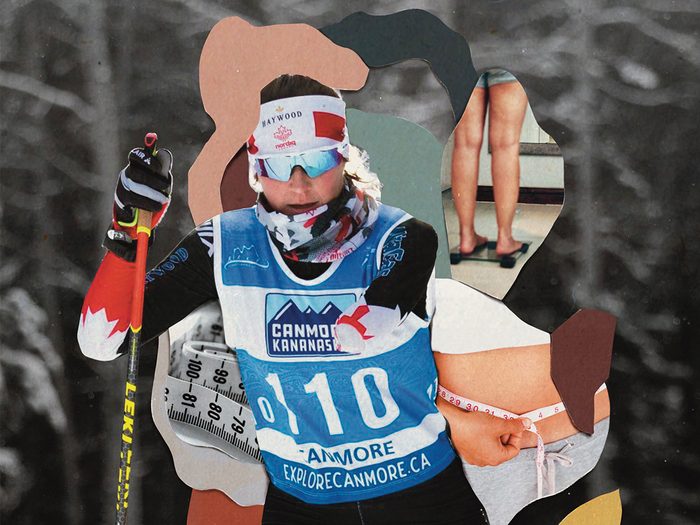Paralympian Brittany Hudak: “I Didn’t Think About Body Image Until I Became an Elite Athlete”

Paralympian Brittany Hudak, who is competing at the 2022 Paralympics in Beijing, shares her experience with body image pressures in elite sports.
I’ve always been fairly lean, but not muscular. I did jazz dancing growing up, and I felt like I had the preferred body type. Like any kid, I was self-conscious, but that was more in relation to my physical disability, which I was born with. I avoided asking for help at school or with activities because I just wanted to be like my peers and prove that I could do the same activities as them. I didn’t think much about body image—until I became an elite athlete.
I was 19 and working at Canadian Tire when I was approached by Colette Bourgonje. The 10-time Paralympian skier, who now mentors Para athletes and encourages athletes with disabilities to get into snow sports, asked if I had ever considered training for cross-country skiing (I hadn’t until that moment). I decided to give it a try, and within two years, I was competing at my first international competition, hoping to earn a spot for the 2014 Paralympic Games in Sochi, Russia.
As I progressed to an elite level of skiing, I started undergoing testing that would demonstrate the progressions of my physical fitness. Every spring and fall, I’d get different parts of my body—from height and weight to the circumference of my thighs and forearm—measured. These measurements provided a snapshot of things like fat percentage, muscle percentage, power to weight ratio.
To be honest, there’s definitely some stress on the day you’re going to be weighed and have skinfolds measured. I found myself wondering what people might think when they saw my data and how these numbers played a role in performance.
Cross-country skiing is endurance based, and there’s this perception that if you have a higher fat percentage, you’re carrying that around the ski course. In high-performance sports, podiums can be won by a matter of seconds. So it can feel like being lean or having less body fat is one way to ski faster, even though that’s not always the case.
This perception, combined with body composition testing, makes it easy for athletes to go down a rabbit hole of self-assessing, thinking, Oh I’m getting bigger, this isn’t good. When we race, we wear skin-tight spandex suits, which can add to the heightened awareness of any aspects of your body that you might be self-conscious about.
But body image isn’t something that we really talk about.
I’m one of those athletes that likes to be self-informed. Why is this in my training plan? What purpose does this workout serve? Over the years, I’ve figured out what works best for me so that I can be my fastest. Sometimes that is being a bit leaner, other times it’s fuelling more in order to maximize how much I can train.
Even though the team measures every part of me, things like menstruation or normal weight fluctuations don’t get discussed. A few years ago, I told my male coach I hadn’t had my period for six months. That conversation was uncomfortable, but it helped us build trust.
The past couple of years, I started talking more openly to my coach about how my numbers will fluctuate slightly throughout the year. We discussed that I might be a few kilos heavier in the summer, but that’s what I need to maintain my energy. Having his feedback that it’s not sustainable for me to be at race weight all the time was critical for me to understand.
These conversations can be awkward at first, but talking about my metrics has really helped me. Being more informed, and talking openly with my coach, has helped me have a healthier mentality towards my body and performance.
Living and training out of Canmore, Alberta, which is a huge skiing hub, I’ve met national athletes from across Canada with so many different body types. It’s helped me recognize that an athlete’s body type alone does not lead to success. We need to balance body composition with individual needs and performance goals.
I once heard someone say, “an athlete is an athlete.” I’ve learned that’s not true. Every athlete is different.
This essay is part of Best Health’s Body Talk package exploring the issue of body image in elite sports. Read more about the experiences of current and former Winter Olympians and Paralympians, and what is being done to make sports a safer space for all athletes, here:
“Fat Doesn’t Fly”: Inside the Culture of Body Shaming in Figure Skating
Speed Skater Alyson Charles: “I Consider Myself Lucky”
Bobsledder Cynthia Appiah: “I Looked Phenomenal, but I Felt Absolutely Terrible”
Alpine Skier Erin Mielzynski: “I Was Just Trying To Be Perfect”
Olympic Legend Catriona Le May Doan: “I Worried About How People Viewed Me My Whole Career”
Get more great stories delivered straight to your inbox by signing up for the Best Health Must-Reads newsletter. Subscribe here.




